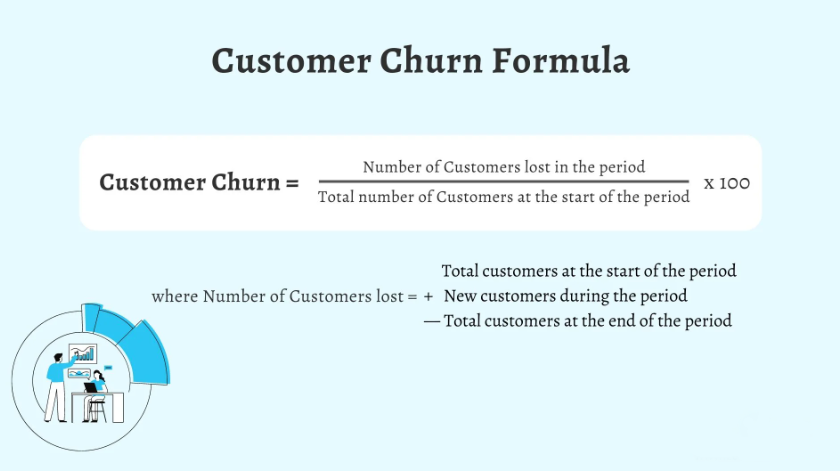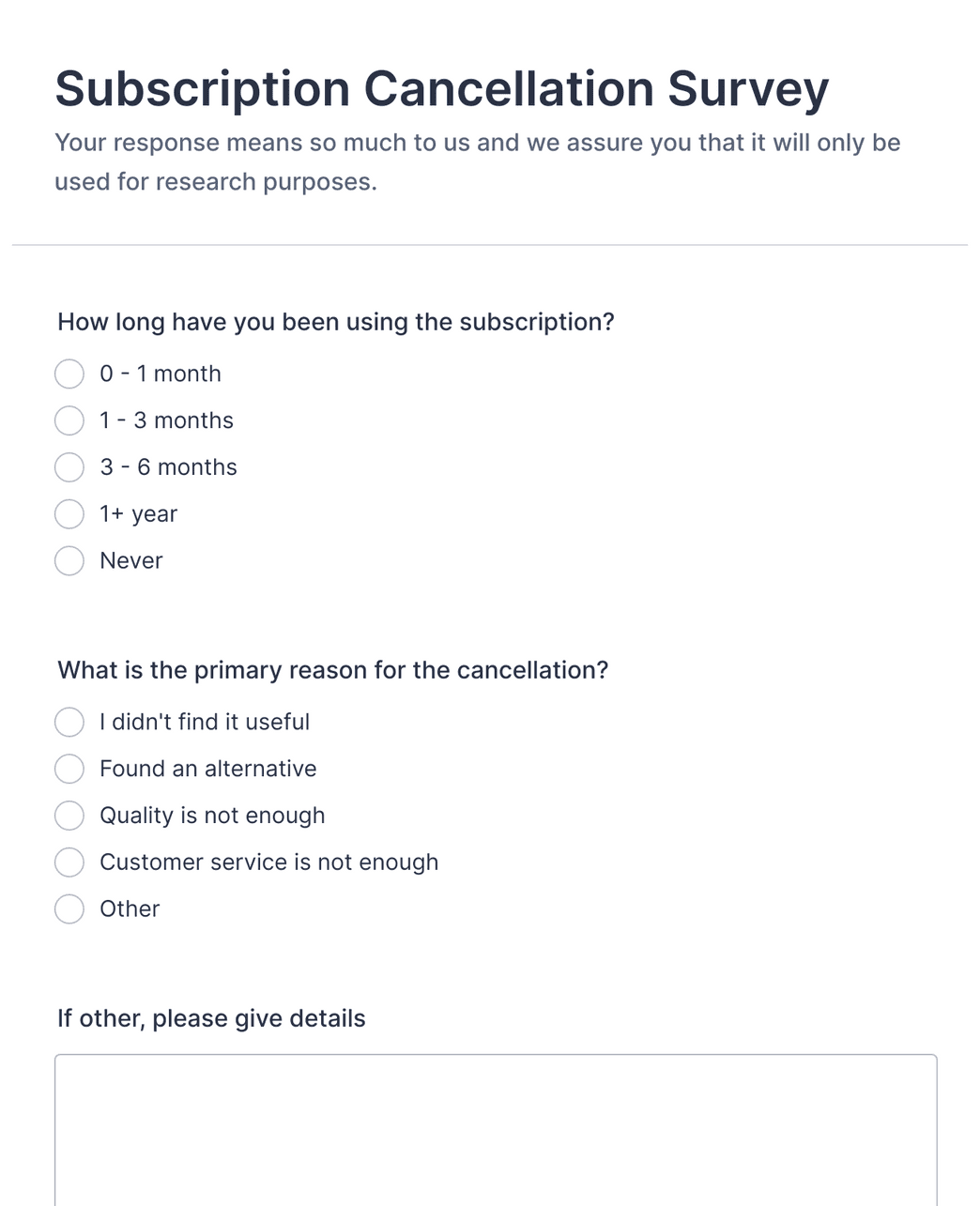Subscription Cancellation Survey: Questions & Best Practices
Want to gather feedback from customers who cancel their subscriptions? Create a subscription cancellation survey with useful questions to ask.
Understanding why customers cancel their subscriptions and effectively addressing those pain points is the key to effectively reducing subscription churn and retaining customers.
When a customer cancels their subscription, it presents a critical moment that offers valuable insights into your business. Sending a survey to inquire about their reasons for cancellation is a smart move, as it provides an opportunity to gain valuable feedback and improve your services.
Unfortunately, many subscription-based businesses fail to capitalize on this opportunity. Instead of contacting customers with a meaningful survey, they often resort to a simple “sorry to see you go” email, missing out on valuable information that could help them better understand their needs and preferences.
Customer retention is a top priority for subscription-based businesses, as high churn rates can significantly impact profits. To deal with this problem, businesses must act to keep their customers. One way they can do this is by using a survey when customers cancel their subscriptions.
This comprehensive guide will delve into the significance of subscription cancellation surveys, explore the key questions to include, and outline best practices for implementation to achieve excellent results.
Understanding Churn and its Impact
Churn is a fundamental metric in subscription-based businesses. It shows how often customers stop using a service within a specific period. This concept helps quantify the number of customers leaving and is important for understanding how to keep customers loyal.

The impact of churn extends beyond a mere numerical representation. The departure of many customers creates significant challenges for a business. High churn rates mean the business loses a lot of money because subscribers are leaving, and the regular income from subscription services gets smaller.
Not only does this hurt financially, it also affects how loyal customers are to the business. If many customers keep leaving, the trust and loyalty of the customer base start to weaken. This makes it harder for the business to keep going and means they have to spend more time and money to get new customers to make up for the ones leaving.
Understanding churn and its implications is important. It’s akin to a health check for a subscription-based business, offering insights into the effectiveness of customer retention strategies and the overall satisfaction of the subscriber base. Dealing with churn is crucial to protect the money coming in and ensure customers stay happy and the business can keep growing.
What is a Subscription Cancellation Survey?

A subscription cancellation survey (a churn/exit survey) is a tool businesses use to gather feedback and insights from customers who have decided to cancel a service or subscription. It serves as a method to understand the reasons behind the cancellation, allowing companies to identify areas for improvement and make informed decisions to enhance customer satisfaction.
Typically administered through online forms or emails, cancellation surveys consist of questions to uncover the customer’s motivations for discontinuing the service. The questions may cover various aspects, such as the overall experience, product features, customer support, pricing, or any specific issues that led to the decision to cancel.
The primary objectives of a cancellation survey include:
Understanding Customer Pain Points: Businesses can pinpoint specific issues or challenges that contributed to the customer’s decision to cancel by asking targeted questions. This insight is invaluable for addressing and rectifying these pain points to prevent further churn.
Gathering Feedback for Improvement: The feedback collected through cancellation surveys provides businesses with actionable data to enhance their products, services, or customer support processes. It helps make necessary adjustments to meet customer expectations and improve overall satisfaction.
Identifying Trends and Patterns: Analyzing responses across multiple cancellations allows businesses to identify trends and patterns. This data can highlight recurring issues that may require systemic changes, enabling companies to implement strategic improvements for long-term customer retention.
Tailoring Retention Strategies: Businesses can develop targeted retention strategies with insights from cancellation surveys. Whether it involves adjusting pricing plans, introducing new features, or refining customer support protocols, these strategies aim to mitigate churn and retain customers.
Maintaining Open Communication: Cancellation surveys allow businesses to communicate openly with departing customers. Acknowledging their feedback and expressing a commitment to address concerns can leave a positive impression, potentially encouraging customers to reconsider their decision in the future.
When to Send Cancellation Surveys
Determining the best time to send subscription cancellation surveys is crucial to gathering meaningful insights from departing customers. Businesses employ different strategies to deploy cancellation surveys for users who intend to churn. There are two primary avenues for this: in-app surveys in real time or email surveys sent post-cancellation.
In-app surveys: These surveys are triggered immediately after the user clicks the cancel button, capitalizing on the moment’s contextual relevance. Given their timely initiation, in-app surveys often yield higher response rates. Moreover, they present an opportunity to re-engage users by offering proactive suggestions based on their responses, potentially preventing churn.
Email surveys: A cancellation survey sent via email typically has lower response rates, as users who have already churned may not be inclined to return and provide feedback. However, those who respond might offer more detailed feedback than in-app, as they’ll have more time to think about their answers.
Our recommendation is to prioritize in-app surveys for immediate and contextually relevant feedback. Afterward, segment users who avoided your in-app questions and send them email surveys. This dual-channel strategy balances capturing real-time reactions and encouraging thoughtful, detailed responses.
Ultimately, when to send subscription cancellation surveys should align with your business model, customer behavior, and the specific goals of your feedback collection process. Regularly reviewing and adjusting the timing strategy based on the feedback received can further enhance the effectiveness of your survey efforts.
Good Questions to Ask Customers When They Cancel Subscriptions
The right cancellation survey questions can make all the difference in achieving a higher response rate. In this section, you’ll find a curated list of questions designed to yield actionable insights into customer experience and product health through your survey. However, be mindful of keeping it short.
Reasons for Cancellation
This inquiry, being the most common, is tailored to understand the precise motivations behind customer churn. Here are some suggested questions:
- What prompted your decision to cancel your subscription?
- Were there specific features or aspects of our service that you found lacking?
- Did you encounter any difficulties or challenges while using our product?
User Experience
This set of questions is designed to provide insights into your customers’ experiences while using your product or service. Consider incorporating the following suggested questions:
- How would you rate your overall experience with our subscription service?
- Were there specific usability issues that played a role in your decision to cancel?
- Can you identify particular features or functionalities that influenced your cancellation decision?
- In your opinion, did our interface and user experience align with your expectations?
- Were there elements of our service that you found particularly challenging?
Value Perception
Below are questions that aim to uncover insights into how customers perceive the value they receive from our subscription service.
- Did you feel that the benefits and features provided by our subscription service justified its cost?
- Were there particular features or services you wished were included in our subscription offering?
- How would you compare the value you received from our subscription service to alternatives in the market?
Customer Support
Below are sample questions to ask your user about your customer support:
- Were you satisfied with the customer support you received during your subscription?
- Did you find our customer support responsive and helpful in addressing your concerns?
Feedback on Improvements
Here are example questions to gather valuable user feedback:
- What improvements or changes would have encouraged you to continue your subscription?
- Is there anything specific we could have done differently to meet your expectations?
- Are there new features or services you would like to see in the future?
Alternative Solutions
- Have you switched to a different subscription service? If yes, why did you choose them?
- What aspects of the new service do you find more appealing than ours?
Likelihood to Return
These questions can significantly inform your subscription cancellation survey:
- On a scale of 1 to 10, how likely are you to reconsider our subscription service in the future?
- What would make you consider returning to our service?
When surveying people canceling their subscriptions, it’s important to consider how many questions you ask. Having too many questions might make fewer people want to answer. Also, it’s good to include questions where people can write their thoughts in their own words. This helps get more detailed feedback and lets customers share their opinions.
Best Practices for Implementing Subscription Cancellation Surveys
Implementing subscription cancellation surveys effectively requires careful planning and consideration of best practices. Here’s a guide to help you make the most of these surveys:
Ensure Concise and Direct Questions: Individuals who have discontinued your service are unlikely to invest significant time figuring out what you are asking them. Utilizing brief and straightforward questions boosts response rates. Moreover, concise, more general questions encourage customers to share insights in their own words, offering more valuable information.
Ask About Specific Aspects: Tailor questions to cover specific aspects of the customer journey, such as user experience, value for money, and customer support. This specificity helps pinpoint areas that need improvement.
Communicate with empathy: Even if a customer has canceled, treating them with empathy and understanding is crucial. This approach is not only the ethical way to interact with people but also increases the likelihood of receiving a response. Furthermore, considering they might reconsider becoming a customer, their experience and perception could influence potential customers through word-of-mouth.
Offer an Incentive (Optional): Consider offering a small incentive, like a discount or access to exclusive content, to encourage customers to complete the survey. However, be cautious to ensure the incentive doesn’t influence the feedback provided.
Personalize the subscription cancellation survey: An effective cancellation survey incorporates a personalized touch. To achieve this, begin by categorizing your customers into segments. Customer segmentation aims to align your communication appropriately. You can craft survey questions that resonate better with each segment by identifying the most effective tone for specific customer types.
Ensure Anonymity (if applicable): Assure customers that their responses will remain confidential and that the survey is about improving services, not identifying individuals. This can encourage honest feedback.
Test Before Deployment: Test the survey internally before sending it to customers to identify potential issues with clarity, length, or formatting. Based on internal feedback, make adjustments to improve the survey’s effectiveness.
Analyzing and Acting on Feedback: Regularly review and analyze the collected feedback to identify common trends and issues. Develop action plans based on the insights gained to address specific pain points and improve the overall customer experience.
By incorporating these best practices, you can optimize the effectiveness of subscription cancellation surveys, turning customer feedback into actionable insights to enhance your subscription-based business on an ongoing basis.
Minimize Subscription Cancellations with Surveys Today
Utilizing the subscription cancellation survey approach proves to be a vital strategy for any subscription-based business aiming to combat churn effectively. As we’ve delved into the ins and outs of this powerful approach, it becomes evident that reaching out to customers when they decide to cancel presents a golden opportunity to gain valuable insights.
By using the questions and best practices outlined in this guide, businesses can handle cancellations well and use them as a chance to get better.
If you are searching for a hassle-free method to manage your membership site and its subscribers, the ProfilePress plugin is the ideal solution for you. It enables you to create subscription plans and earn recurring revenue by creating restricted content for your members. Additionally, it offers member management and subscription management features to help you manage your site more efficiently.